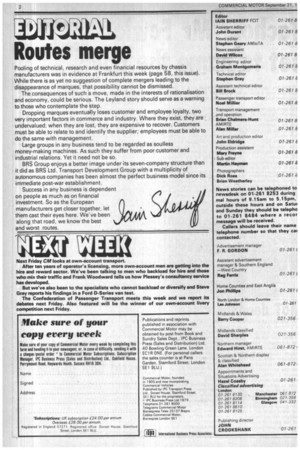Routes merge
Page 4

If you've noticed an error in this article please click here to report it so we can fix it.
Pooling of technical, research and even financial resources by chassis manufacturers was in evidence at Frankfurt this week (page 58, this issue). While there is as yet no suggestion of complete mergers leading to the disappearance of marques, that possibility cannot be dismissed.
The consequences of such a move, made in the interests of rationalisation and economy, could be serious. The Leyland story should serve as a warning to those who contemplate the step.
Dropping marques eventually loses customer and employee loyalty, two very important factors in commerce and industry. Where they exist, they are . undervalued; when they are lost, they are expensive to recover. Customers must be able to relate to and identify the supplier; employees must be able to do the same with management.
Large groups in any business tend to be regarded as soulless money-making machines. As such they suffer from poor customer and industrial relations. Yet it need not be so.
BRS Group enjoys a better image under its seven-company structure than it did as BRS Ltd. Transport Development Group with a multiplicity of autonomous companies has been almost the perfect business model since its immediate post-war establishment.
Success in any business is dependent on people as much as on financial investment. So as the European manufacturers get closer together, let them cast their eyes here. We've been along that road, we know the best and worst routes.












































































































































